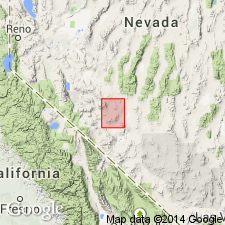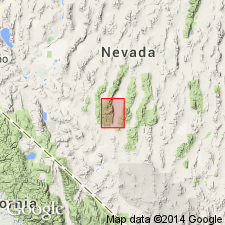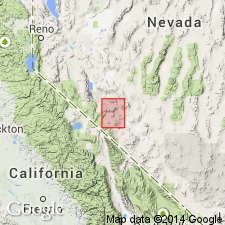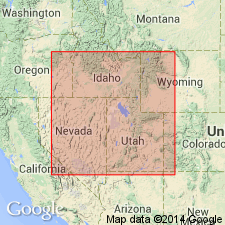
- Usage in publication:
-
- Diablo formation*
- Modifications:
-
- Mapped
- AAPG geologic province:
-
- Great Basin province
Summary:
Diablo formation. In Coaldale quadrangle, unit is largely dolomite with some interbedded sandstone, grit, and conglomerate. Only fossils are corals. Thickness in Monte Cristo Range is about 500 feet; elsewhere not over 300 feet. Age is Permian.
Source: GNU records (USGS DDS-6; Menlo GNULEX).

- Usage in publication:
-
- Diablo formation*
- Modifications:
-
- Areal extent
- AAPG geologic province:
-
- Great Basin province
Summary:
Described and mapped in Round Mountain 15' quad, NV, where unit is more than 3000 ft thick in Toyabe Range. Gradationally underlies Pablo formation (new). Age is Permian based on characteristic fossils of Phosphoria formation.
Source: GNU records (USGS DDS-6; Menlo GNULEX).

- Usage in publication:
-
- Diablo formation*
- Modifications:
-
- Named
- Biostratigraphic dating
- Dominant lithology:
-
- Sandstone
- Grit
- Conglomerate
- Dolomite
- AAPG geologic province:
-
- Great Basin province
Summary:
Type locality designated for sandstone [facies] as crest and west slope of Mount Diablo and hills to the west; for dolomite [facies], hills west of road, one mi north of Columbus, Mina 15' quad, NV. West of Candelaria unit consists of coarse sandstone and grit and locally thin basal conglomerate. Near Candelaria contains lenses of brown dolomite which increases eastward and forms entire section north of Columbus. Sandstone in western part is not over 200 ft thick. Unconformably overlies Palmetto formation; unconformably underlies Candelaria formation. Age is Permian based on characteristic Phosphoria fauna [brachiopods] in sandstone and corals and brachiopods in dolomite.
Source: GNU records (USGS DDS-6; Menlo GNULEX).

- Usage in publication:
-
- Diablo Formation*
- Modifications:
-
- Biostratigraphic dating
- AAPG geologic province:
-
- Great Basin province
Summary:
Diablo Formation has conodont and brachiopod fauna, brachiopods of Leonardian and Roadian (late Artinskian age) and conodonts of Roadian age in eastern outcrop. In western outcrop, unit has brachiopods of Wordian (early Guadalupian age). Wordian is considered Late Permian age according to subdivision chart of Permian Series of Furnish (1973). [Wardlaw (1979, in U.S.G.S. Prof. Paper 1163-B, p.8) shows USGS usage of Wordian Stage as of Early Permian age].
Source: GNU records (USGS DDS-6; Menlo GNULEX).
For more information, please contact Nancy Stamm, Geologic Names Committee Secretary.
Asterisk (*) indicates published by U.S. Geological Survey authors.
"No current usage" (†) implies that a name has been abandoned or has fallen into disuse. Former usage and, if known, replacement name given in parentheses ( ).
Slash (/) indicates name conflicts with nomenclatural guidelines (CSN, 1933; ACSN, 1961, 1970; NACSN, 1983, 2005, 2021). May be explained within brackets ([ ]).

